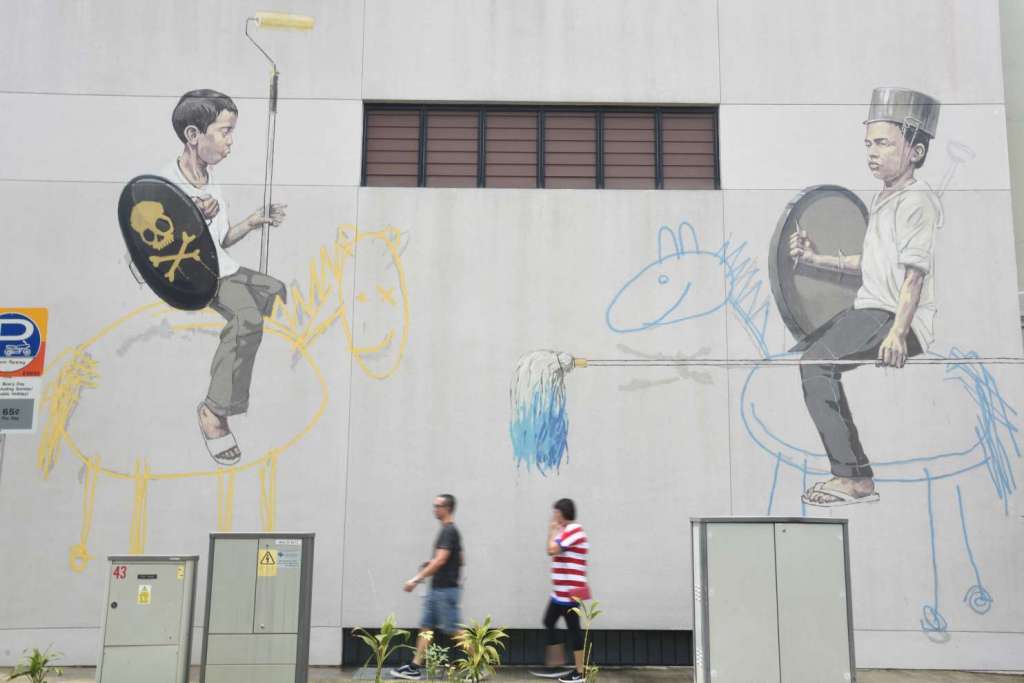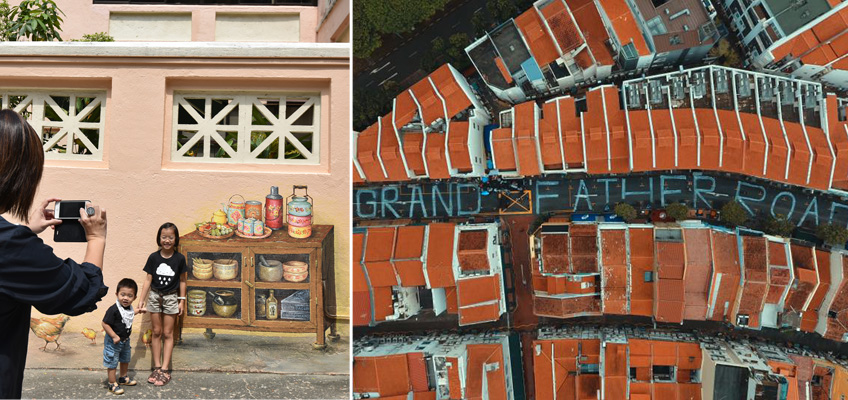Four years after getting on the wrong side of the law for painting the words “My Grandfather Road” at roads around Robinson and Maxwell in 2012, artist Samantha Lo has done it again – albeit legally this time.
A 170m-long stretch of Circular Road was stencilled with the exact words using chalk paint by Lo and her team of nine on Nov 5, as part of the Singapore River Festival.
In a Facebook post on Thurs (Nov 10), the 30-year-old artist described her latest artwork as “one of the most challenging pieces to date”.
More commonly known as “Sticker Lady”, Lo also grabbed headlines in 2012 when she pasted stickers with phrases such as “Press Until Shiok” and “Anyhow Paste Kena Fine” on the buttons of traffic lights at pedestrian crossings, leading to her arrest for vandalism.
She was later charged with mischief and had to serve 240 hours of community service.
Her grandfather road installation may be gone for now, but here are other 10 other artworks to check out around Singapore with your family (and grandfather):
Self-taught muralist Yip Yew Chong, 47, is enjoying a flourishing second career.
He specialises in nostalgic heritage scenes. Since painting his first mural in Everton Road in August last year – depicting an old-school barbershop and a maid handwashing a kebaya – he has worked on 19 murals, including recent commissions by Plaza Singapura mall for its heritage corner and Hotel NuVe, a budget hotel in Jalan Pinang.
His other works are scattered across the island, in places such as Waterloo Street and Tiong Bahru.
In a way, the low-key artist is one of Singapore’s most prominent muralists, but art is only a sideline for this trained accountant, who works in finance. He spends time on his commissions on weekends.
Though he wishes not to be pigeonholed as a heritage muralist, he recognises that the popularity of his work stems from Singaporeans’ love of nostalgia. “I get a lot of older Singaporeans telling me they can recognise the scenes,” he says.
Artists like him are helping to fuel the growth of Singapore’s public mural scene. Look around heritage and hipster areas such as Arab Street and Tiong Bahru or random facades of shops and housing estates and one will see more artworks adorning the walls.
Although they may be painted in different styles, their subjects often refer to the neighbourhood’s history, culture and identity.
This comforting sense of local heritage has proven a draw for many business owners, which have commissioned such mural art to add colour to their premises. Even government agencies are recognising their appeal.
Six-month-old restaurant The Singapura Club in Haji Lane commissioned a mural for its facade, depicting a labourer wearing a turban, a Samsui woman and a Malay man. The artwork, done by graffiti artist Ceno2 using spraypaint, refers to the heritage of Arab Street and the multi-ethnic identity of the restaurant, which serves Asian and North Indian food.
Guinness Singapore recently worked with home-grown artist Ben Qwek to create murals in Jalan Besar to coincide with the launch of a limited-edition of its Foreign Extra Stout.
The three murals highlight local cultural icons as well as Ang Ji Gao, Hokkien for “red-tongued dog” – a reference to the famous dog on the brand’s bottles and cans.
Although heritage themes are most common, murals here come in different artistic styles.
At Skyville@Dawson, a Housing Board (HDB) estate in Queenstown, architecture firm Woha worked with local comic artist Troy Chin to create murals cast onto more than 50 panels of concrete.
The panels, which depict scenes from Queenstown past and present, took about six months to fabricate at a construction site in Sungei Kadut. While the work bears Chin’s signature stark linework, he had to eschew fine lines which would have crumbled easily.
The 39-year-old says: “The HDB was pretty ballsy. It was a gamble for it to work with me. I lucked out.”
Public artworks are sometimes executed in a graffiti or street-art style.
While doing graffiti on public and private property without permission is illegal and considered by the authorities as vandalism, a “sanitised” form of it has become popular.
To encourage young artists to express themselves, there are some walls here on which graffiti is legal, such as those at Somerset Skate Park and Aliwal Arts Centre.
At the arts centre, graffiti artists can hone their skills on a wall at the back of the building. Full-time graffiti artist Slac Satu, whose real name is Rozaimie Sahbi, 36, says the 12m- wide, 4.5m-tall wall is one of the few places where he can practise creating large-scale works.
The wall has a makeover every few months, undertaken by a roster of artists managed by street-art collective RSCLS, a resident of the building.
Even as permanent murals are prettifying neighbourhoods, they face certain restrictions when it comes to conserved buildings or buildings in conservation areas.
The Urban Redevelopment Authority says murals done on conserved shophouses are generally allowed on side walls, “where they do not affect the main facades of the buildings”. The art also needs to “respect the character and context of the place and public norms and sensitivities”.
Acknowledging that street art “adds a welcome spontaneity and energy to our arts scene”, the National Arts Council’s deputy director of arts and youth, Ms Aruna Johnson, says the council has been working with public and private partners “to open new spaces for street art practice”. These places include *Scape in Orchard Road and Goodman Arts Centre.
Ms Venus Teoh, head of marketing at Asia Pacific Breweries Singapore, which distributes Guinness here, says: “Street-art murals are sometimes seen as vandalism in Singapore. However, if done appropriately, it is a great venue for selfexpression.”
The Guinness murals were done in Jalan Besar, an area chosen for its “distinct heritage”.
Ms Teoh says: “We also hope this inspires consumers to look at the area in a different light and with new-found appreciation for our heritage neighbourhoods.”
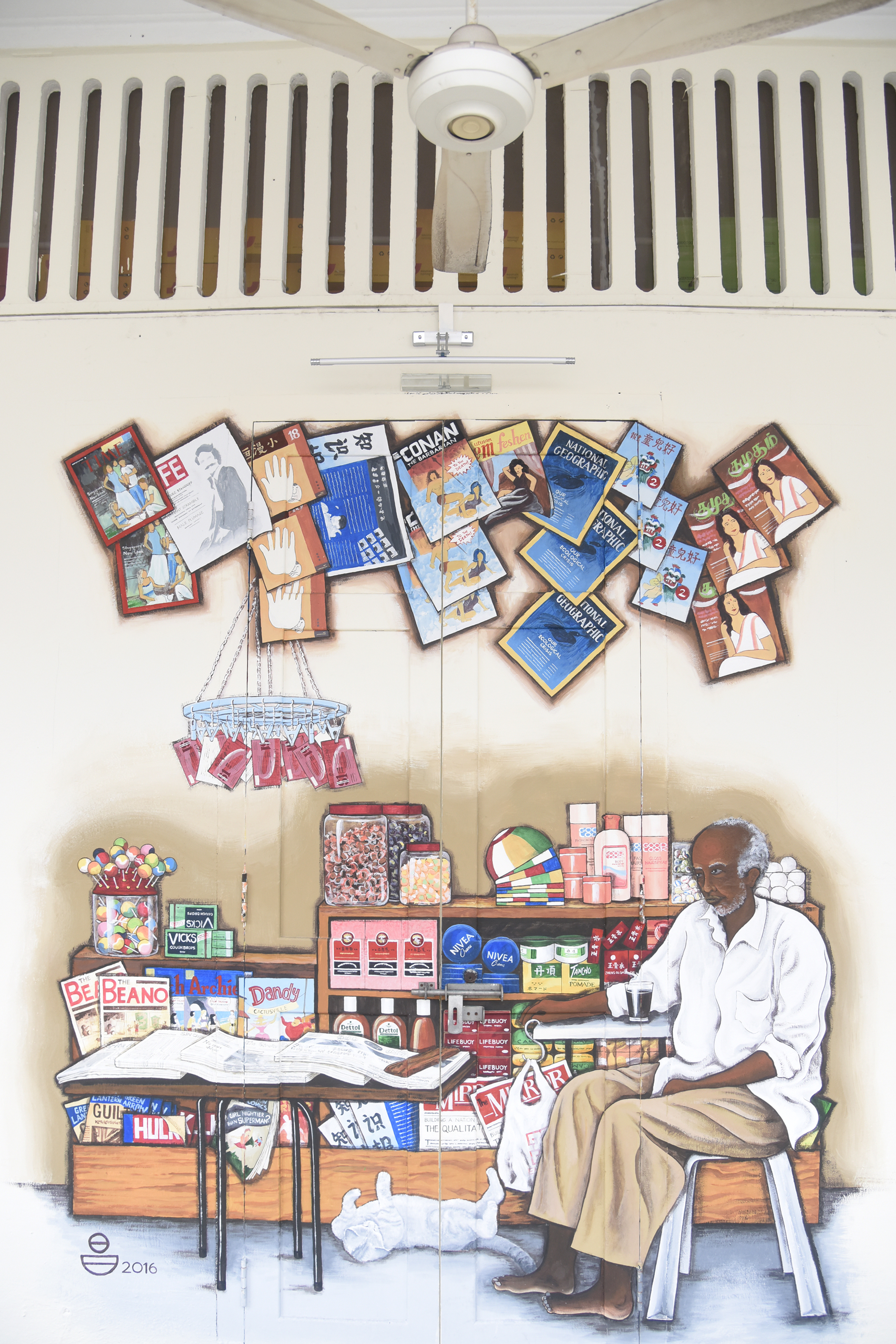
1. Art with heritage theme
Where: 222+51 at 51 Waterloo Street/222 Queen Street
MRT: Bras Basah
On the ground floor of this arts centre are six murals depicting historical scenes of the area.
For example, one artwork features the lobby of the old Odeon Cinema in North Bridge Road, complete with an Indian kacang putih seller and posters of movies such as Malay screen legend P. Ramlee’s Patah Hati (1952) and the first Star Wars (1977).
Or meet Fatimah, a seamstress who works in an army supplies shop – a mural recalling the many such shops that were located in the Beach Road Army Market.
The murals, which incorporate the building’s existing wooden door panels into their designs, were done by Singapore artists Yip Yew Chong and Yuen Kum Cheong.
The works were commissioned by the owners of 222+51 this year to celebrate the 80th anniversary of the building, which used to be the former Catholic High School.
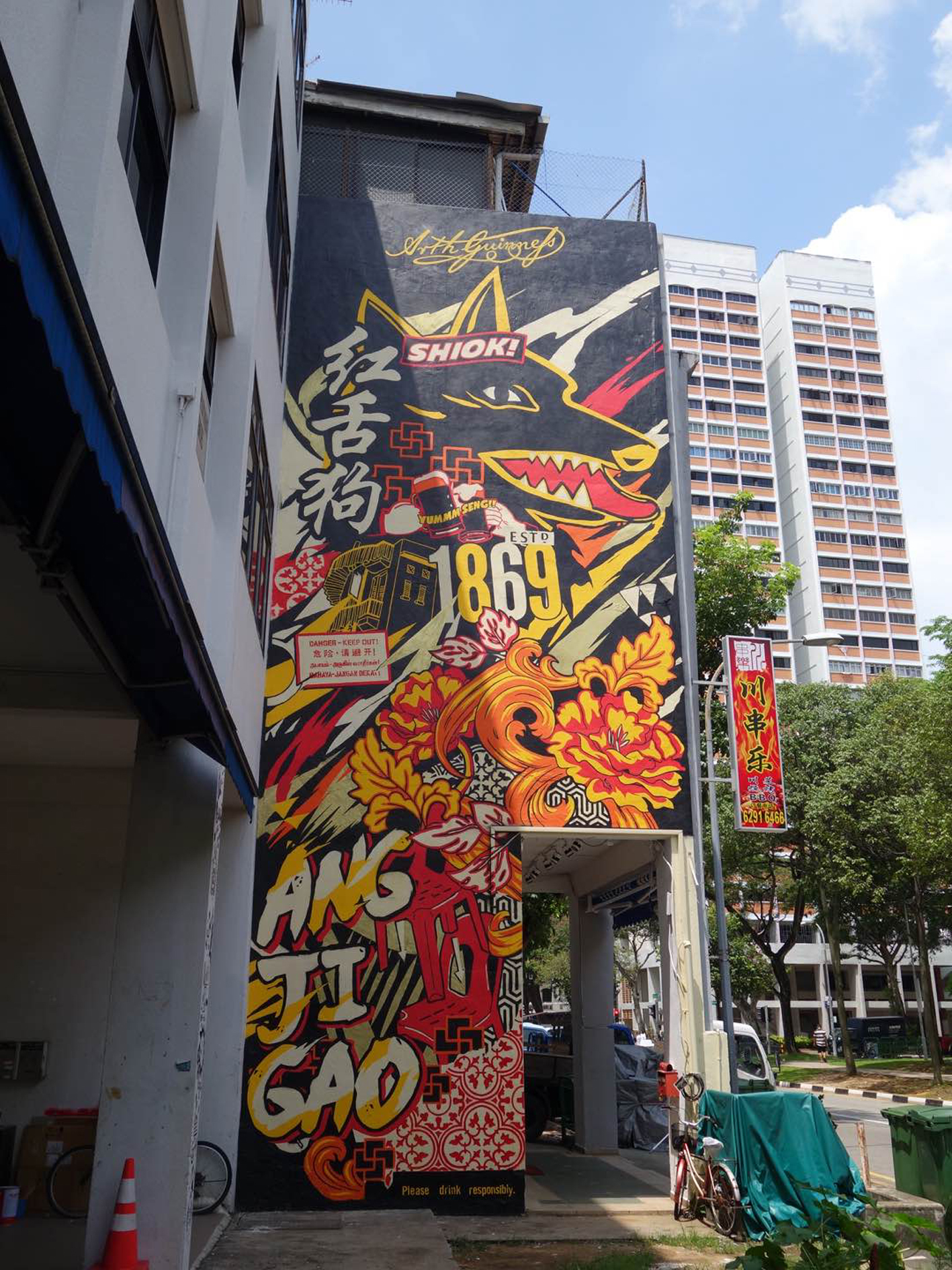
2. Ang Ji Gao on the walls
Where: 254 Jalan Besar (along Plumer Road), 64 Horne Road and Hamilton Road
MRT: Lavender
To launch a limited-edition version of Guinness Foreign Extra Stout in April, Guinness Singapore commissioned home-grown artist Ben Qwek to create three murals in Jalan Besar.
Completed in May, the artworks are loud and brash, incorporating the iconic red-tongued dog on Guinness’ label, as well as local subjects such as the red plastic chairs in kopitiams and kueh tutu.
The mural also has the words “Ang Ji Gao”, meaning “red-tongued dog” in Hokkien, a common term local Chinese men use to refer to the beverage.
Qwek also designed the special-edition bottles and cans along a similar theme.
Ms Venus Teoh, head of marketing at Asia Pacific Breweries Singapore, which distributes Guinness in Singapore, says: “Ben’s bold bright designs on the pack worked really well in incorporating the local elements that we hold dear, and thus we commissioned him to paint these street art murals as his expression of the Singapore spirit.”
3. Same artist behind iconic murals in Penang
Where: Junction of Joo Chiat Terrace and Everitt Road
MRT: Eunos
One of the main attractions for visitors to George Town, Penang, is the lively street art in the heritage city. In fact, a wall mural of a pair of children screaming in glee while riding a bicycle – with a real one propped against the wall – has become an iconic tourism image of the Malaysian city.
That, and many other playful murals in George Town that interact with real-life objects, were done by Lithuanian artist Ernest Zacharevic.
He has left his mark in Singapore too. A 2013 mural, painted on the side of a private building in Everitt Road, features two children play-fighting with a paint roller and a mop dipped in paint.
His other works here, featuring children sitting in trolleys and peeking out from windows, can be found on the facade of events and marketing company amc asia! singapore’s building in Jalan Klapa and Jalan Pisang. They were completed in 2013.
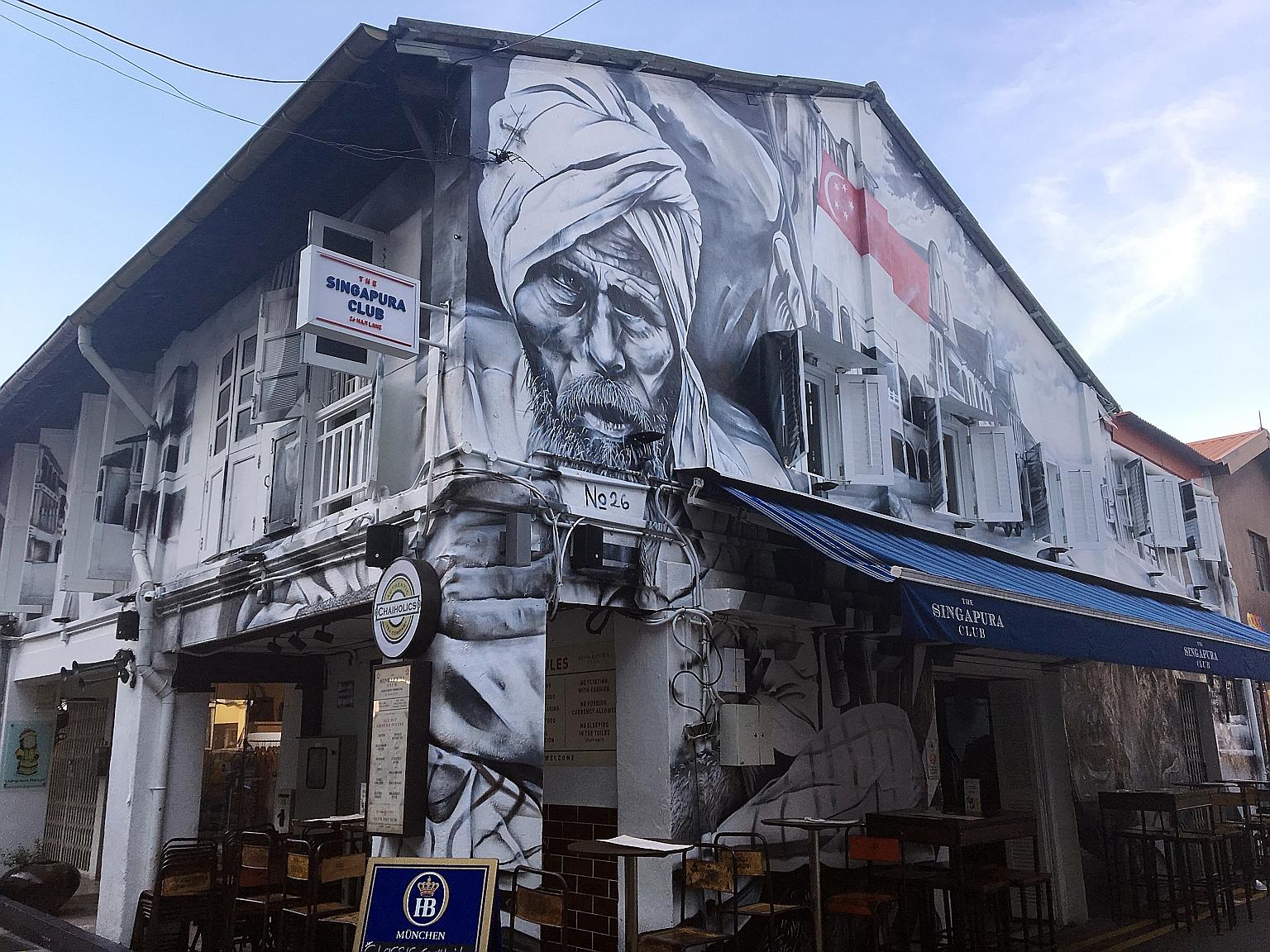
4. Faces from the past
Where: 26 Haji Lane
MRT: Bugis
It is hard to miss the 15m-high man in a turban drinking chai in Haji Lane. He is spraypainted on the facade of The Singapura Club, a six-month-old restaurant that serves Asian and North Indian cuisine.
The work is by graffiti artist Ceno2, who is known for his photo-realistic human portraits.
He spent about three weeks to complete this artwork, working from 11pm to 4am daily.
Although the man is the most eye-catching character on the wall, the mural features other subjects, such as close-up faces of a Samsui woman as well as a Malay man.
Mr Jerry Singh, who owns The Singapura Club and commissioned the piece, says the elderly and historic characters reflect the heritage of the neighbourhood.
Passers-by love the work. Mr Singh estimates that between 100 and 200 photos are taken of it every day. He also gets many queries from tourists and locals about the mural.
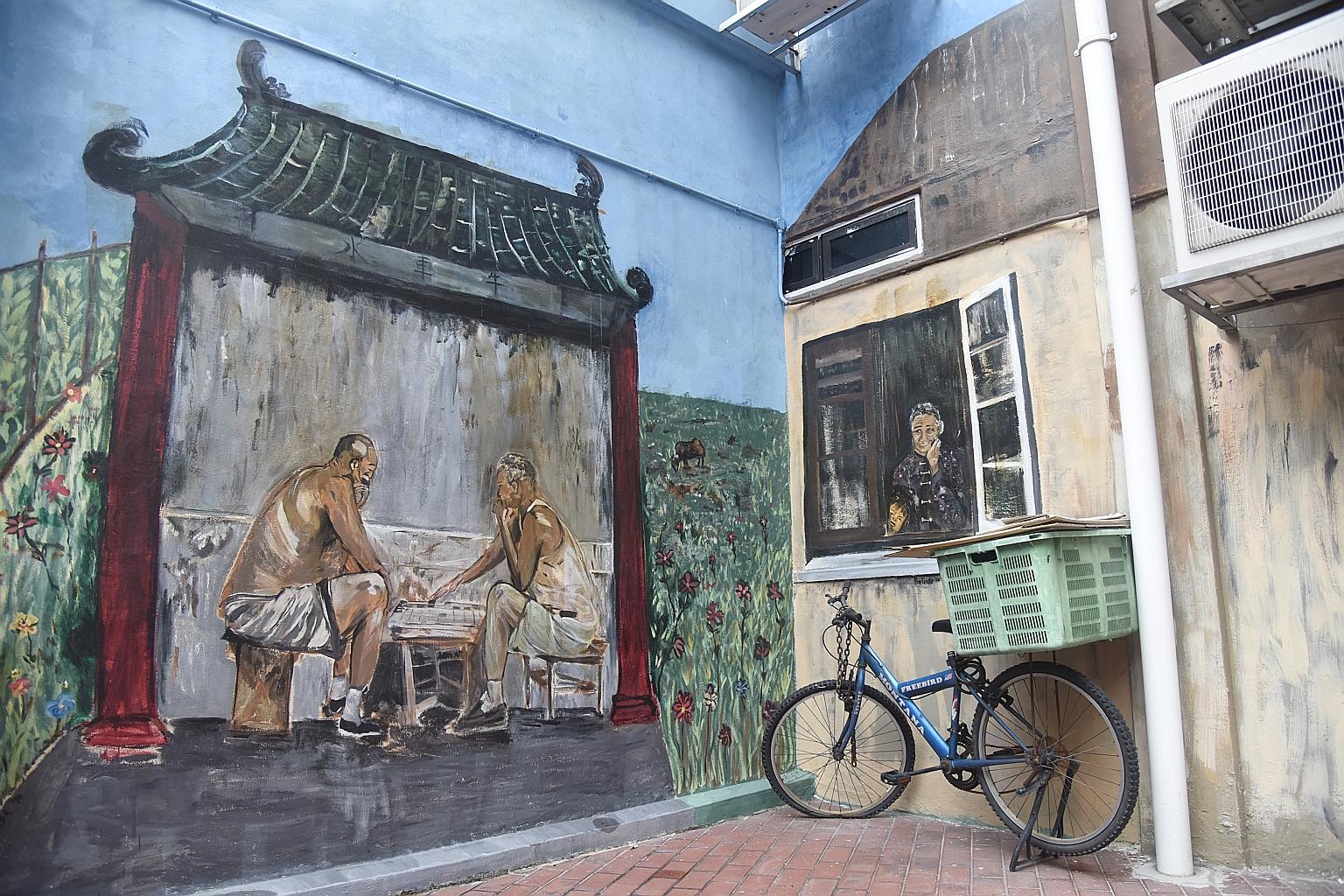
5. Old days of Chinatown
Where: Block 4 Sago Lane, Block 5 Banda Street and Block 333 Kreta Ayer Road
MRT: Chinatown
Created by 500 volunteers from accounting firm Pricewaterhouse- Coopers together with 100 Kreta Ayer residents, this set of 13 murals draw on Chinatown’s heritage and modern-day scenes.
Look out for details such as two men playing a game of chess (above) and an erhu player sitting on the steps of a shophouse.
Spread out around the Banda Street area, the murals are part of Colouring Banda Street 2015, a charity initiative by the accounting firm.
Its employees also donated daily necessities to elderly residents living in the one- and two-room flats in the area.
The murals were handpainted over six months, with the largest measuring 18.5m by 3.7m.
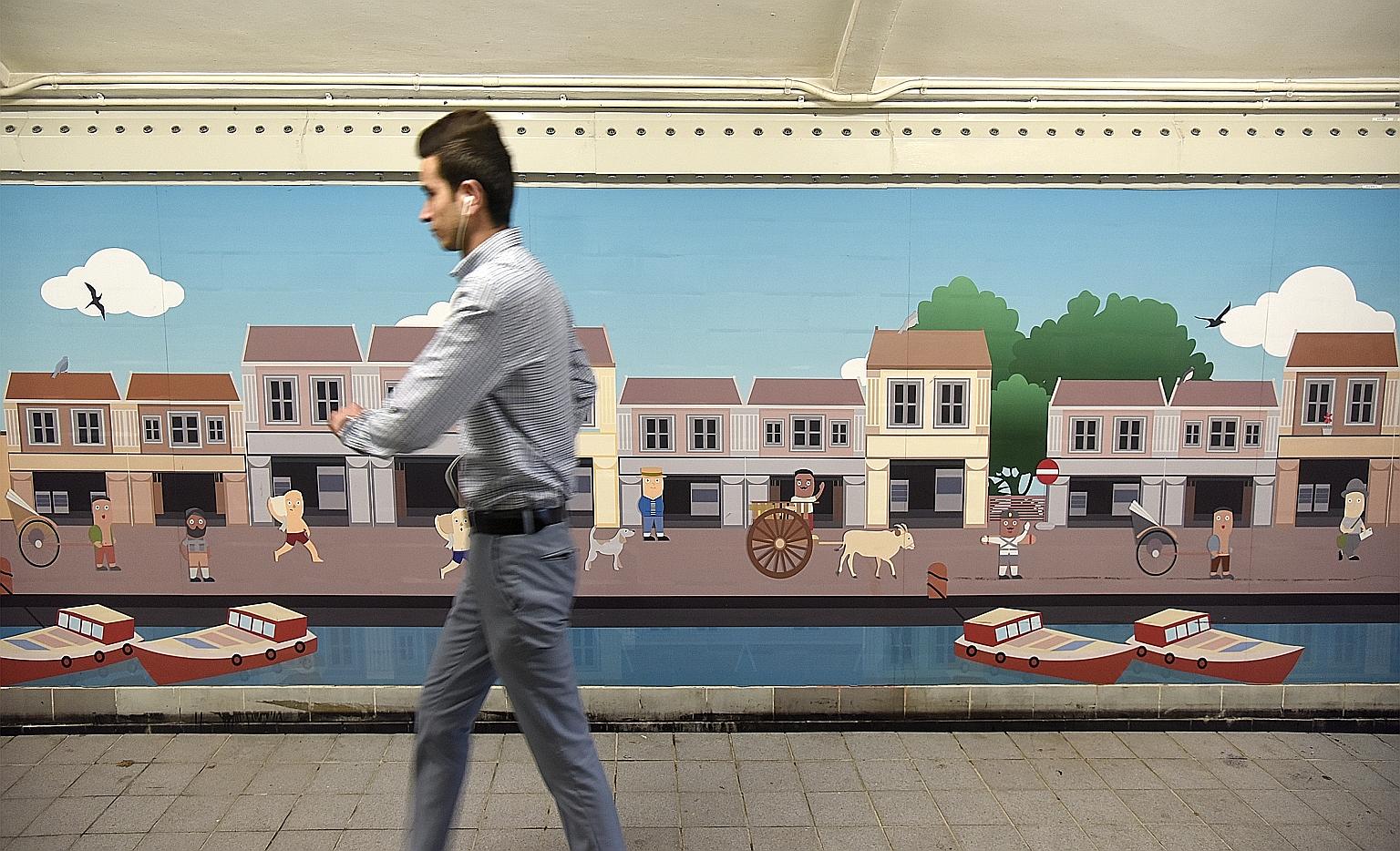
6. History in an underpass
Where: Elgin Bridge underpass, North Bridge Road
MRT: Clarke Quay
Enlivening the Elgin Bridge underpass are two murals celebrating the history of the Singapore River – in particular, the area around Boat Quay.
Unveiled last year as part of the SG50 celebrations, the works were created by students of Raffles Design Institute and feature a graphic, blocky style. Characters are depicted in flat, 2D shapes that look almost like computer icons.
The 27m-long, 2.19m-high murals stretch across the length of the underpass.
The Back To The Past mural features the trade activities and transportation that took place against the backdrop of Boat Quay shophouses, such as bullock carts and bumboats carrying goods.
The Early Days mural (above) focuses on the people working along the Singapore River, such as rickshaw pullers, merchants and labourers.
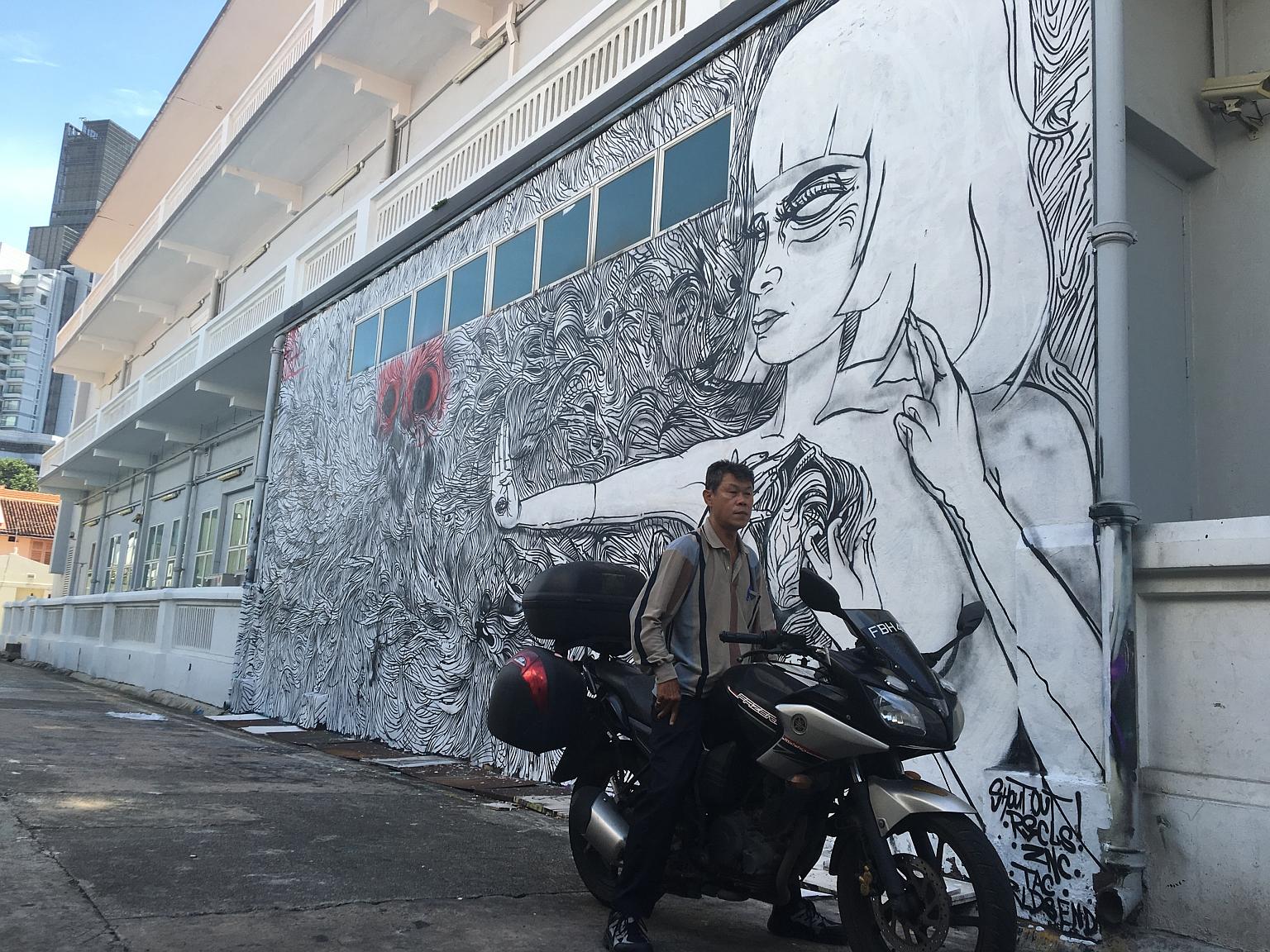
7. Ever-changing graffiti art
Where: Aliwal Arts Centre, 28 Aliwal Street
MRT: Bugis/Lavender/Nicoll Highway
At the back of Aliwal Arts Centre is a wall of artwork that changes every one to six months.
Right now, there is a black-and- white mural (above) featuring a woman peeling open her chest, by home-grown graffiti artist Kilas.
Some time later, it will be replaced by another work by another street artist or group of artists.
The wall is “managed” by street- art collective RSCLS, which has a studio in the arts centre. Other groups which have taken over the wall so far include duo Ink&Clog and graffiti collectives Zinc Nite Crew and Three Flare Krew.
Ms Natalie Tan, Aliwal Arts Centre’s senior manager of place- making, says tourists and visitors often come specifically to see the works.
How often the graffiti art is renewed is an “organic” process and depends on “artists’ schedules and inspiration”, she adds.
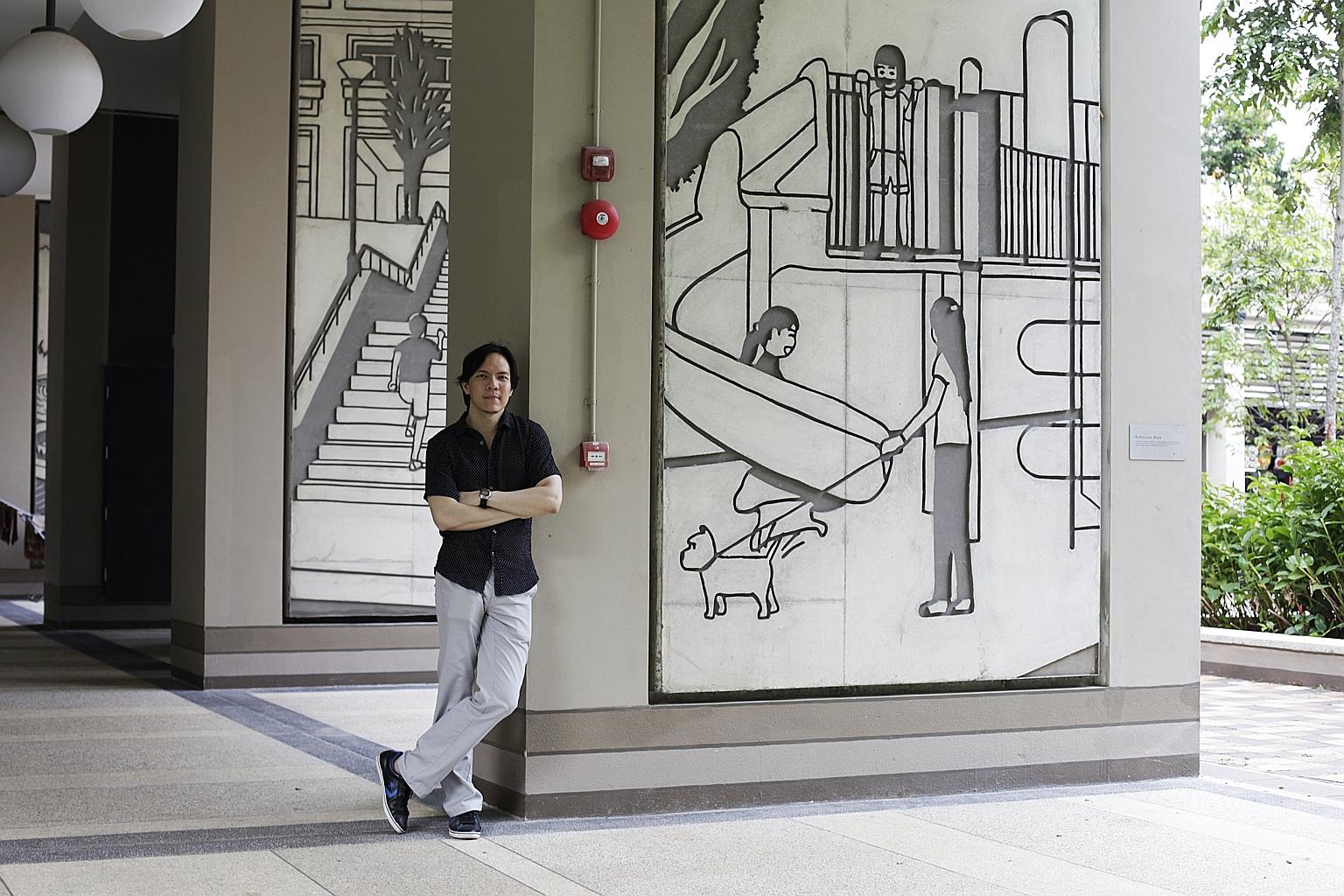
8. Concrete reliefs at Skyville@Dawson
Where: Skyville@Dawson, 86 Dawson Road
MRT: Queenstown
Sleek, graphic and monochrome, these murals at Skyville@Dawson by comic artist Troy Chin (above) differ from the usual street-style art that adorn building walls.
These concrete reliefs, which have the simplicity of woodcut prints, are themed around life in the Queenstown area from its kampung times to the present day.
Ms Pearl Chee of architecture firm Woha, which designed the housing estate, says some panels “capture early life in the Dawson and Queenstown area, such as kampungs and fishing in the canal, and places that people remember in their stories and memories”.
There are more than 50 concrete panels in the three-block estate, including about 30 lining the walls of a common walkway.
Chin, 39, is known for his series of graphic novels titled Resident Tourist, featuring a semi- autobiographical character who feels out of place in Singapore.
As this is his first mural commission, he learnt a lot about how a public artwork can interact with its surroundings.
“I didn’t expect the shrubs to grow so high and partially block one of the panels. But I don’t mind, it’s supposed to be connected to the environment,” he says.
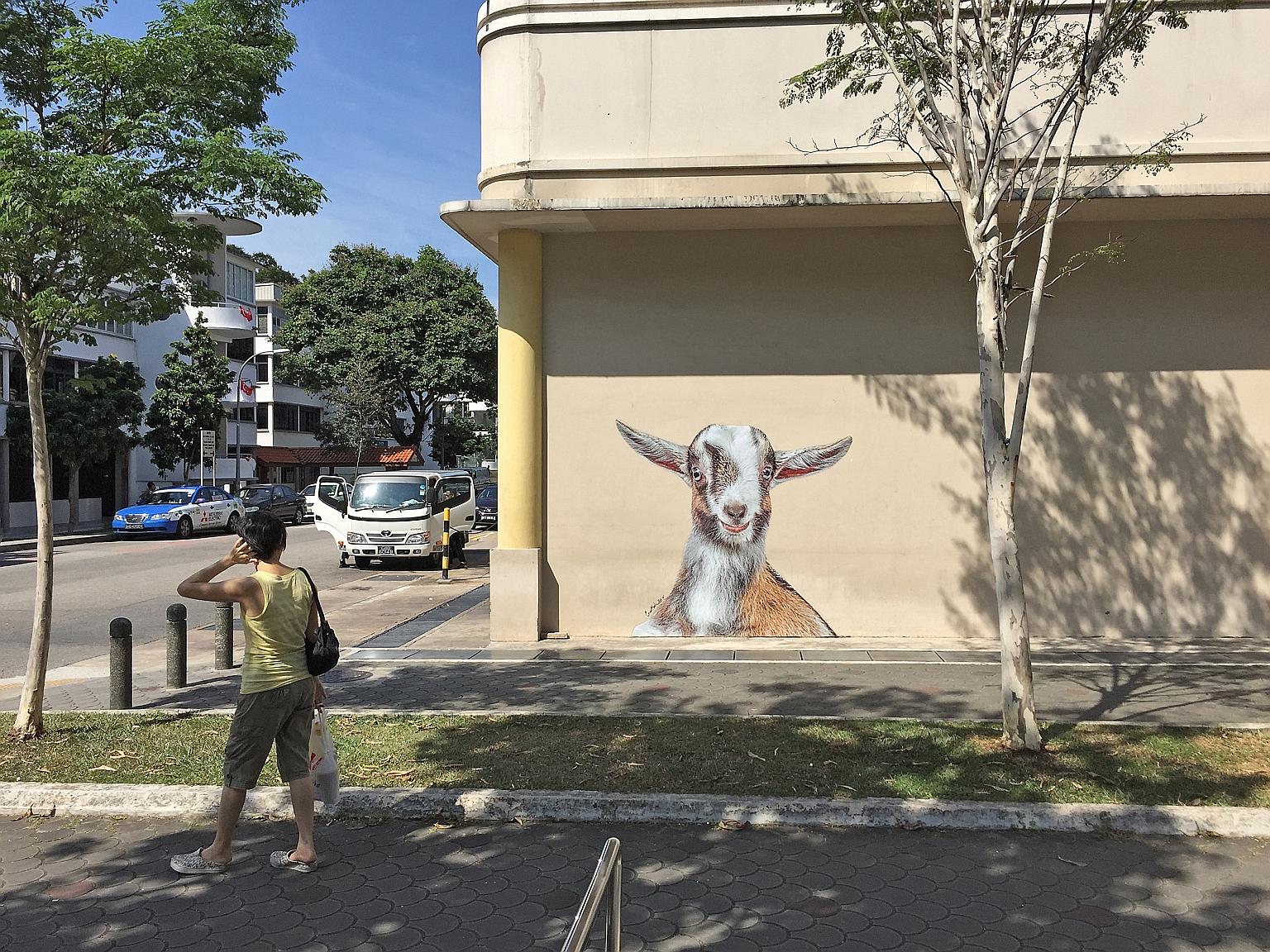
9. Watch out for goats in Tiong Bahru
Where: In and around Tiong Bahru market, 30 Seng Poh Road
MRT: Tiong Bahru/Outram
In 2014, artist Ernest Goh created three murals at the Tiong Bahru Market for the Chinese Year of the Goat.
These billy goat paintings continue his animal-inspired series, which he started in the neighbourhood in 2013.
For many hipsters, the three chickens and two fish painted around the pre-war apartments and shophouses provided many photo opportunities over the years. But of these artworks, only one goldfish near the Tiong Bahru Post Office survives.
The images are printed on paper and then applied on the wall using a wheat-pasting method, where wheat flour and water are used as an adhesive. This, says Goh, 37, is “a cheap and fast way to put up murals”, compared with painting or spray painting.
Asked about his subject matter, he said he wanted to depict animals that used to be found frequently in the kampungs in Singapore, such as the wandering chickens and fish in the longkangs.
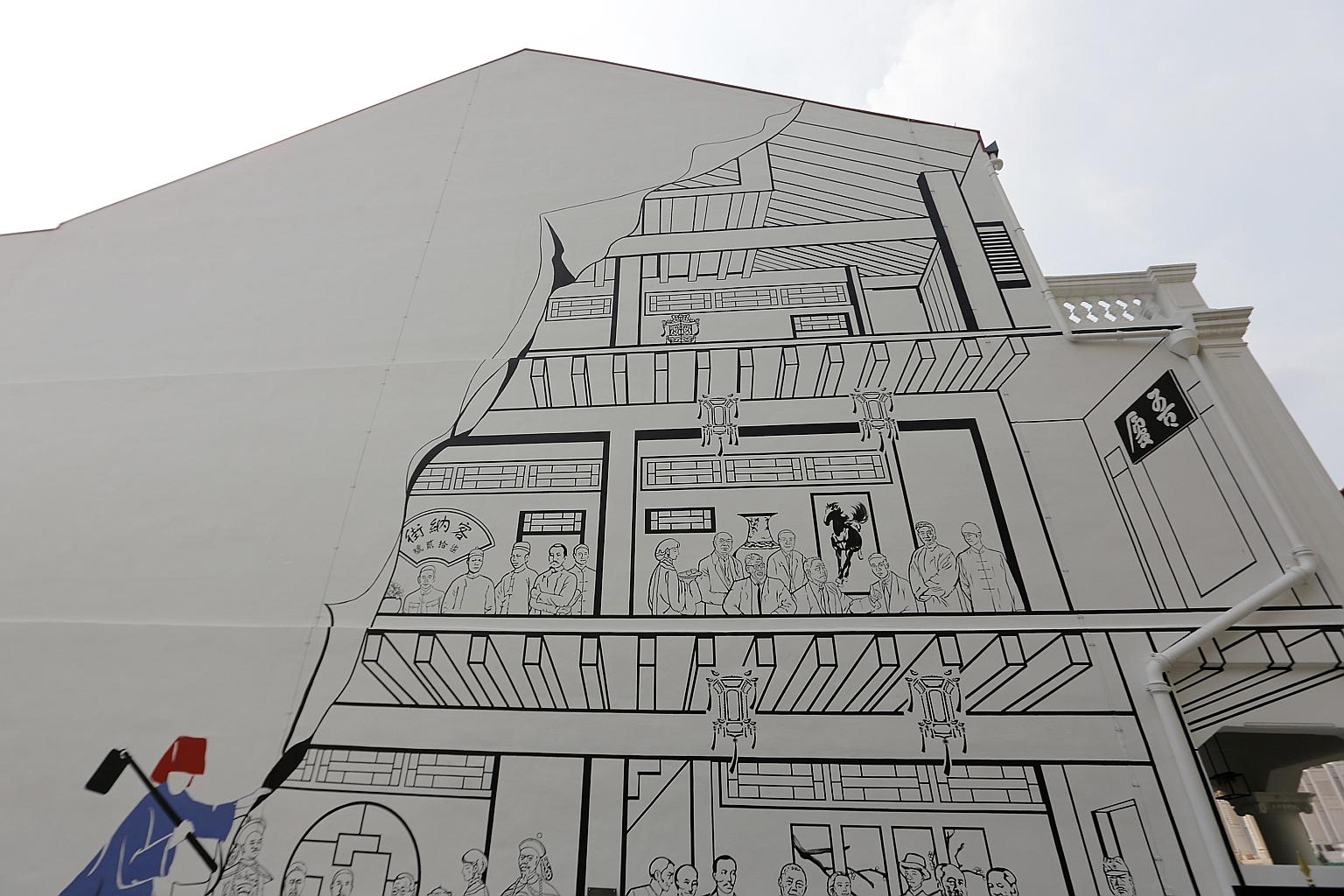
10. Building’s history on facade
Where: Goh Loo Club, 72 Club Street
MRT: Telok Ayer
In this artwork on the side of the 111-year-old Goh Loo Club, a Samsui woman “peels away” the wall to reveal a historic scene in the three-storey shophouse.
The mural works like a cross-section of a doll house. Looking in, one can see genteel, old-fashioned rooms decorated with lanterns, paintings and elaborate Chinese window screens.
The occupants are historical too, comprising men in long Chinese tunics and Western suits.
Painted by Singapore artists Benny Ong, Zhao Jian Wen and Didier Ng, this mural recreates what Goh Loo Club was like in the early days when it was a place where the local Chinese community and visiting dignitaries gathered. The mural’s cast of characters include businessmen, Chinese revolutionary figure Sun Yat Sen and a Japanese soldier guarding a door.
The building underwent a major renovation in the interiors, which saw it clinching an Architectural Heritage Award this year.

This article was first published on Nov 11, 2016.
Get a copy of The Straits Times or go to straitstimes.com for more stories.
